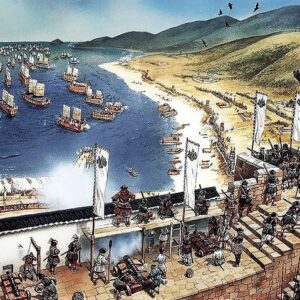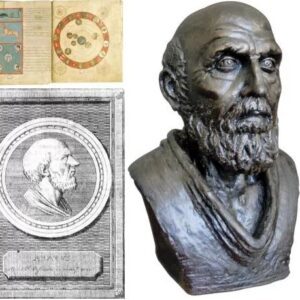Babylon, which used to be situated on the bank of the Euphrates river, was one of the most influential cities in the ancient world. Despite its fame for the hanging gardens, there are still many mysteries surrounding the city. In a nutshell, let’s explore what Babylon was really like.

Digital painting of the ancient Babylonia, an epic landscape illustration
Where’s Babylon?

The Etemenanki (Sumerian for: “temple of the foundation of heaven and earth”) was a massive ziggurat dedicated to Marduk in ancient Babylon
Babylon was the capital of Babylonia, in the southern part of Mesopotamia. It is one of the most well-known cities of any ancient civilization. Approximately 60 miles south of Baghdad, Iraq, is where that is now.
When did Babylon become the center of such a massive empire, and how did it happen?

A lion, depicted in profile and representing strength and power, is among the animals that adorn the Ishtar Gate, which was built around 575 BC by King Nebuchadnezzar II of Babylon. The gate was constructed using fired bricks and decorated with glazed brick animals, and it was located along the processional way leading into the city of Babylon.
Babylon’s early history remains largely unknown, although ancient records suggest that it may have functioned as an administrative center approximately 4,000 years ago. In 1894 BC, a leader named Samuabum from an area near present-day Syria conquered the city and established a small kingdom. However, when Hammurabi ascended to the throne as the city’s sixth king in 1792 BC, Babylon underwent significant changes.
Who was Hammurabi? What did he do?

During his reign from 1792 to 50 BC, Hammurabi expanded the city-state along the Euphrates River and conquered several old cities including Ur, Uruk, Isin, and Larsa. As a god-like leader of a powerful empire, Hammurabi introduced new rules to his people in the form of the Code of Hammurabi, which was written around 1754 BC and consisted of 282 laws.
The Code was engraved on a four-ton basalt and is currently on display at the Louvre Museum in Paris. Violating these laws could result in severe punishment such as having one’s tongue, hands, breasts, eye, or ear removed. However, the Code of Hammurabi is also one of the earliest examples of the presumption of innocence until proven guilty.
Babylonian society was divided into three categories: property owners, free citizens, and enslaved individuals. For instance, if a doctor killed a wealthy patient, he would face the punishment of having his hands removed, but if the victim was enslaved, he would only be required to pay monetary compensation.
What happened following Hammurabi’s reign?

A Babylonian obelisk found in 1911 bearing an inscription depicting a Babylonian King and the ziggurat of Etemenanki
After he died, the empire fell apart, making Babylonia easy to take over by the Hittite Mursili I in 1595 BC. After him, a series of Kassite Kings who came from the Zagros Mountains northeast of Babylonia and ruled peacefully for about 500 years took over. During this moment, the Babylonian language spread throughout the Middle East, and the empire’s power became more stable.
When did Babylonia’s economy start to grow?

The city of Babylon
Between 1200 BC and 600 BC, the Babylonian Empire was plagued by frequent wars between Assyria and Elam, causing much instability. However, in 605 BC, Nebuchadnezzar II ascended to the throne and embarked on a series of military campaigns that expanded the empire significantly, stretching from the Persian Gulf to the borders of Egypt. Nebuchadnezzar also initiated an ambitious building and reconstruction program within the city of Babylon, including the construction of massive shrines, three grand palaces, and the Ishtar Gate, the primary entrance to the inner wall of the city.
What Happened to the Tower of Babel?

The Tower of Babel is a famous story in the Book of Genesis, but not much else is known about it. The tower itself was said to be the tallest man-made structure at that time, built by the people of Babylon after they were released from their captivity
The Tower of Babel is mentioned in the first book of the Bible, the Book of Genesis. It is often thought of as a mythical building. Still, it has also been linked to real Babylonian buildings, such as the Etemenanki, a pyramid-like ziggurat built around 610 BC and dedicated to the god Marduk. The building was more than 90 meters tall but torn down after Alexander the Great took Babylon.
What were the Hanging Gardens of Babylon?

This hand-coloured engraving by the 16th-century Dutch artist Martin Heemskerck depicts the fabled Hanging Gardens of Babylon, one of the Seven Wonders of the World.
The Hanging Gardens of Babylon were considered one of the Seven Wonders of the Ancient World, and according to legend, they were built by Nebuchadnezzar for his wife, Amyitis, who missed the greenery of her homeland. Despite their fame, the exact location of the gardens remains a mystery, with many historians believing that they were a series of tiered gardens containing trees, bushes, and vines. While there have been efforts to locate the gardens, the search has been largely unsuccessful, leading some to doubt whether they ever truly existed.
In the End, What Happened to the Ancient City?

In 539 BC, the Persians captured Babylon, but the city continued to thrive as a hub for art and education. Following the defeat of the Persian Empire by Alexander the Great in 331 BC, the city was ordered to remain intact. However, after Alexander’s death, the empire was fought over, and the people of Babylon were forced to abandon the city, leading to its gradual decline. In the 1980s, Saddam Hussein, the then-leader of Iraq, undertook significant rebuilding efforts in Babylon, resulting in very little of the original city remaining today.





